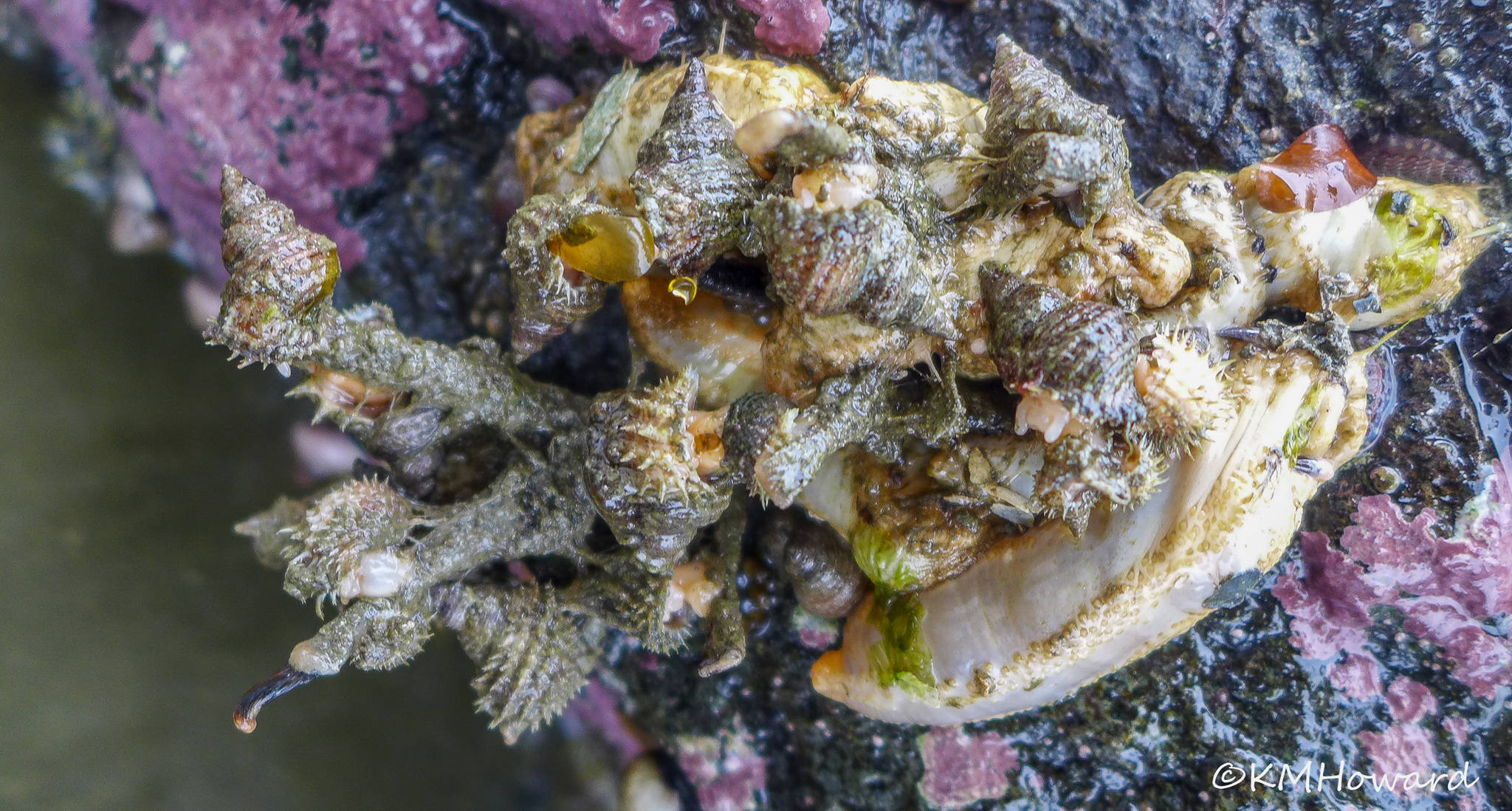On the next-to-the-lowest tide in late April, some friends and I explored the intertidal zone not far from town. We soon catalogued all the usual beasts, but several observations really caught my fancy.
Three tiny, bright red hermit crabs (very cute!) guarded their protective periwinkle shells with their big claws. We counted over 70 small king crabs, all less than an inch in carapace width. There were lots of five-armed sea stars, but one had only three arms and one had only two arms, with no signs of regeneration. So we wondered about the feeding success of these crippled stars, with so few arms for pulling open clams; how does their diet differ from that of intact stars, and how long does it take to get enough nutrition to regenerate those missing arms?
Among all the small fishes that lurked under boulders were two large crescent gunnels, at least 8 inches long. They were so dark that the crescent marks on the backs were hard to see; these individuals were reddish on the lower parts of head and body and were probably males. The heads of two flatfish lay on a low ledge. The bodies of both fish behind the gills had been gnawed off, leaving a ragged margin. Someone had feasted well — probably otters, which commonly eat these fishes tail-first, and crabs may also have picked off a few bits.
The biggest puzzle was a heap of fuzzy-looking snails piled up on a mound of mostly indistinguishable material. We had no idea what this was, so I asked an expert and did some reading. Here is what I learned: These snails are known as Hairysnails (currently classified as Trichotropis cancellata). The shell bristles with hairs, and experiments have shown that the hairs deter some, but not all, predators. This snail lives in the North Pacific, usually sub-tidally, so the very low tide on this day was fortuitous for us.
Hairysnails are sequential (protandrous) hermaphrodites: as they mature they are male first and then gradually turn into females as they grow. Bigger snails produce larger clutches of eggs, increasing their reproductive output, while size is less important to male reproductive success, so for this species it pays to start reproducing (as a male) when small and producing eggs, lots of them, when large. During the transition time, they can sometimes function as both sexes at the same time — researchers have seen pairs of snails in which both snails are being male and female simultaneously.
The feeding habits of Hairysnails are fascinating. They can feed on small organisms suspended in the water but, more interestingly, they are kleptoparasites—stealing food particles right out of the mouths of tube worms (they are rarely seen parasitizing other potential hosts). The tube worms feed by catching plankton on their waving tentacles and funneling the prey to their mouths, and the snails just cling to the side of the tube and reach out with an extended lower “lip” to snap up incoming prey. The snails that we saw were all clinging to a conglomeration of tube worms, ready to snatch food particles when the tide came up again.
Worms thereby suffer a reduced growth rate, but the sneaky, thieving snails grow much better — up to 18 times faster than when simply suspension feeding. Small, immature snails, including those that are only a millimeter in size, gain the most in growth from their kleptoparasitism, but larger ones are also able to reproduce better. In most places, there is only one kleptoparasitic snail on a given tube worm, but occasionally there are two or even three, potentially in competition for stolen prey.
Hairysnails mate and lay eggs in winter, and in that season the adults generally leave their hosts and occupy themselves with reproductive activities. Males come back to stealing from tube worms when they are done mating, but females tend their batches of eggs for a while, and thus return to their hosts later than the males do. Small snails, less than about 5 millimeters in size, do not leave their hosts seasonally, but continue to thieve and grow.
Kleptoparasitism, in reference to stealing food from another animal, is widespread in the animal kingdom. Birds are perhaps the best studied: frigatebirds, jaegers and skuas, and some terns are well-known for harassing other birds that have caught a fish, making the victim drop the fish for the pirate to grab. In Berners Bay, we watched young glaucous-winged gulls, acting like teenage hoodlums, chase other gulls until the prey was dropped. We sometimes see eagles forcing another eagle or an osprey to drop its fish. Among insects, cuckoo-bees lay their eggs on the pollen balls made by queen bumblebees for their own larvae and thus are stealing food from the bumblebee larvae. Web-building spiders may lose their prey to other spiders or to flies. Hyenas sometimes harry lions at a kill until the lions depart, letting the hyenas take much of the lions’ prey; and sometimes lions steal from hyenas. Those are just a few examples, but researchers say that kleptoparasitism occurs in every major taxonomic group of animals. Humans are not exceptions!
Sometimes the concept of kleptoparasitism is broadened to include the stealing of any useful item from another animal. So male bowerbirds that swipe alluring objects from each other, in order to decorate their own bowers, are kleptoparasites. So, too, are penguins robbing each other of stones used in their nests or tree swallows forcing a chickadee to give up its nest for the swallows’ use. Again, humans are not exceptions!
Thanks to Dr. Aaron Baldwin, ADFG, for sharing some of his extensive knowledge of marine invertebrates and providing literature references.
• Mary F. Willson is a retired professor of ecology.

